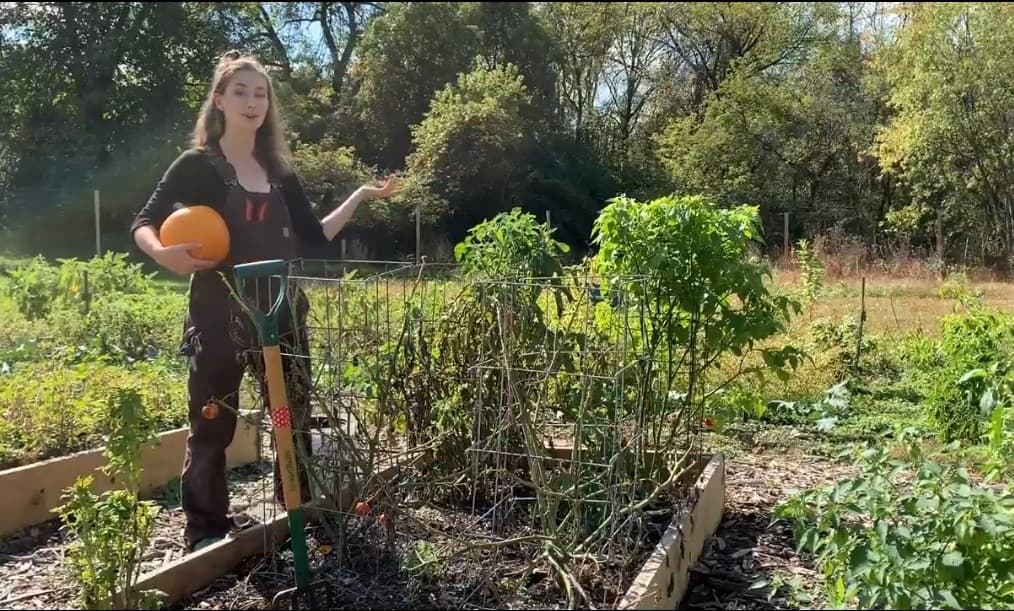4 End-of-Season Fall Gardening Tips
Most of our community gardeners wrap up their plots around the beginning of November, but there’s so much you can still do to prepare for the “end” of the season! Check out our October Easton Out Loud video here, and the tips below, for how we’re prepping for the end of the growing season at the community gardens.
1. Make the most of your current plot
We live in the 6b Plant Hardiness zone in Easton, meaning that we can typically expect our “first frost” in mid-October. Before our non-hardy annual plants die off for the season, you can…
- Harvest all your green tomatoes! They can ripen on a warm windowsill inside and be eaten, instead of freezing in the field.
- Dig up pepper plants to be stored indoors for winter. Pepper plants can have a long life span and produce for many seasons if given the right care, as warm-loving plants. First, pull off all ripe peppers and pull dead leaves. Then prune about 2/3 of the plant down (yes, it will look like a lot!). Dig up your plant, trying not to damage much of the roots if possible, and replant with soil and fertilizer into a medium-sized pot. You can take your pepper plant indoors and leave it near indirect lighting for a few days as it heals, then keep it near a window or with a grow light (4 to 5 hours of sun) for the winter until warm enough to plant outdoors again. Remember not to overwater – peppers don’t like wet roots.
- Harvest any herbs and prepare them by drying (tie into small bundles and hang to dry). Have grow lights or a sunny window? You can also dig up your herb plants (like described with the pepper plants above) and continue growing them on the windowsill with extra care.
- Cold-loving plants like kale and broccoli should be fine growing into the fall, especially with a boost of warmth from floating row cover. If you want to extend the season a bit longer, you can use row cover and metal hoops to create a slight greenhouse effect, covering the plants and hoops directly and weighing the cover down with stakes, rocks, etc. Row cover is also great for pest control.
2. Improve your soil health
Fall is a great time to think about amending your soil so it’s rich for next growing season.
- After removing any diseased plants from your plot and composting any dead plants, cover your plot about 2 to 4 inches thick with compost. You can use a digging fork to incorporate it into the first few inches of garden soil, or plan to incorporate it in the spring when you till. Adding compost provides beneficial soil microorganisms, improves soil drainage, and will slowly release nutrients to your plants during the growing season.
- Another way to add ‘green manure’ to the soil is by cover cropping. Cover crops in zone 6b should be planted about a month before frost. Oats and buckwheat work well at the community gardens! Crops can be tilled into the soil.
3. Plant bulbs
- Garlic can be planted here in mid-October, and will produce bigger, more flavorful bulbs than when planted in the spring. Break the garlic bulb apart clove by clove (but do not peel), and then plant each clove pointed end facing up 2 inches deep and 6 inches apart from other planted cloves. Mulch with a few inches of leaf litter or straw, water the bulbs, and wait for spring. In mid-May, remove mulch and keep the soil moist. Garlic will be ready to harvest in June or July.
- It’s also a good time to plant bulbs for spring flowers. We’re planting tulip bulbs and allium bulbs, which both thrive with our area’s cold winters. Daffodils and hyacinths also work well here. What bulbs can’t survive Easton’s winters? You’ll want to pull any canna, calla lily, and dahlia bulbs (then wrap them in newspaper and store in a dark, moderately warm space like a basement) until spring.
4. Look forward to spring
Cleaning up and organizing your garden in the fall will make the spring season much more enjoyable. Decide what you’d like to see in your spring plots, and start considering a crop plan for next season with a planting calendar.
- Clean and store your tools for next season. Sharpen your clippers and mower blades. Empty water tanks and unhook rain barrels from the gutter.
- Seed any sparse areas of your lawn, and lay straw around mid-September.
- Protect tender plants (like young fruit trees or shrubs) with burlaps sacks if they’re not cold-hardy. Secure wooden stakes or a metal cage around the plant, then cover with burlap, tying or stapling it around. This will help keep the plant warm, and will keep the snow/ice (including any on the burlap) off to avoid damaging it.
- Yes, many of the annual plants in your garden can be cleared out for a clean space for next season. However, leaving some plants “messy” is helpful – you can leave your dead sunflowers intact for birds to nibble on, for example. This is helpful for pollinators, and they may reseed the space for sunflowers for next season on their own.


